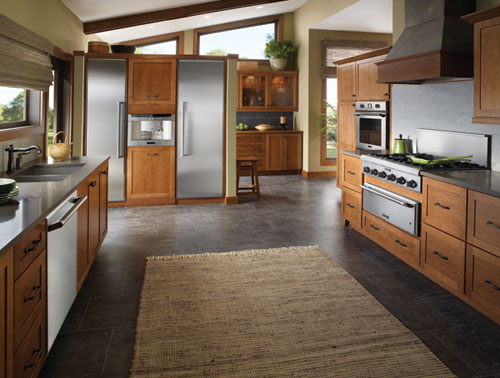Luxury in the Kitchen
Quiet Operation. The compressor keeps the refrigerator cool. A standard compressor circulates cool air on a set cycle. But at the heart of quiet operation is a variable speed compressor, which keeps running at very slow revolutions per minute, and cycles up only when necessary to maintain the temperature of the products inside the cabinet. Some companies even insulate the compressor in higher end models.
Greater Capacity. Manufacturers are continually working to gain extra capacity within the same footprint. One way of doing this is through more effective insulation technology. Proprietary vacuum panels reduce the thickness of refrigerator walls, and thinner walls mean more room inside. A partial vacuum is created within the panel walls and filled with a low conductivity substance such as powder, fiber or aerogel. Increased energy efficiency is another byproduct as heat gain in the refrigerator is reduced, thereby reducing the energy required to maintain lower temperatures within.
Environmental and Energy Considerations
Refrigerators are moving toward more positive environmental and energy performance.
Refrigerants. There has been a movement toward a new generation of environmentally friendly refrigerants. Hydrofluorocarbons (HFC), a group of compounds containing carbon, fluorine and hydrogen, but not chlorine, have replaced chlorine-containing chlorofluorocarbons CFCs and hydrochlorofluorocarbons (HCFC). HFCs, however, are not an ideal solution as they have a global warming impact. Major HFC releases occur during their manufacture, from filling refrigeration equipment and from refrigerators' end-of-life deterioration.
Other substances being tested as an alternative to HFCs are greenhouse-neutral hydrocarbons such as propane and isobutane, which are extensively used in European and Asian refrigerators. The drawbacks are that these substances carry slight flammability concerns and are currently not UL approved or sanctioned by building codes in many municipalities.
Energy Efficiency.A refrigerator runs 24/7, and in a typical home, generates 8 percent of the total annual energy expense, according to 2005 data from the U.S. Department of Energy. Compared to the 1970s, when a new refrigerator averaged 1,800 kilowatt-hours (kWh) per year, the best of today's versions log in only about 500 kWh annually. Recent improvements in insulation and compressors have cut some of the fat out of energy usage. Variable speed compressors, for example, save energy by operating at ultra slow revolutions per minute rather than shutting off and turning on again, which expends energy unnecessarily. Refrigerators and freezers with individual compressors generate only the energy required to keep their own compartment properly chilled. Adaptive defrost systems operate only when needed, and there are settings to adjust temperatures for low food levels, to disable ice making and lighting when users are on vacation and to function in Sabbath mode, meaning that lights, fans, sounds, alarms, compressors or other electrical activity is disabled when the refrigerator door is opened without affecting its operation.
 |
Flush-mounted refrigeration is a top trend in kitchen design. Photo courtesy of Thermador |
All refrigerators sold in the United States are required to meet the Department of Energy's efficiency standards, and many meet the department's more stringent Energy Star qualifications as well. A new refrigerator with an ENERGY STAR label is required to use at least 20 percent less energy than stipulated by current federal standards. Today's Energy Star rated refrigerators use about half the energy of those manufactured prior to the early 1990s. Through its rating system of appliances, the program claims to have helped save enough energy in 2008 alone to avoid greenhouse gas emissions equivalent to those from 29 million cars − all while saving consumers $19 billion in utilitly costs. However, when it comes to free standing refirgerator ratings, the Energy Star program is not without its critics. Detractors decry the lack of independent auditors − manufacturers supply data on their own products − and contend that the energy efficiency bar is set too low, with too many products qualifying for the star to make it meaningful. For built-in refrigerators, Energy Star criteria are more rigorous. The built-in installation makes the heat exchange to the outside more difficult than freestanding units, and the air inlet and air outlet for cooling air are more restricted in the built-in installation. In addition, outside dimensions are fixed due to the built-in cabinet and so with a given interior volume, more insulation can not be added than the outside dimensions allow. Freestanding units have more tolerance.
 |
Today's kitchens feature sophisticated cooktops, built-in ovens and warming drawers. Photo courtesy of Thermador |









